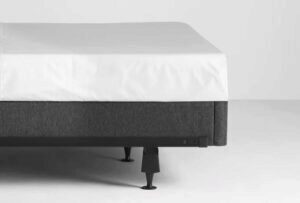Do I Need a Mattress Protector?
Disclosure: By clicking on the product links in this article, Mattress Nerd may receive a commission fee at no cost to you, the reader. Read full disclosure statement.
A mattress protector might be the most important accessory to have for your mattress. There seems to be a lot of confusion about what a mattress protector does, with some people thinking it’s just a gimmick that salespeople use for upcharging their customers. It baffles me that so many people sleep on mattress without a mattress protector. So what does a mattress protector do?
What does a mattress protector do?
A mattress protector accomplishes four things:
- Keeps the mattress clean. Human bodies are pretty gross. We all perspire at night. We all produce oil from our skins. Some of us wear makeup. We all also shed dead skin cells. There are plenty of other activities that can leave their mark. All of this can soak through your sheets and into the mattress. Once a little gets into your mattress, it’s almost impossible to get it out of your mattress. A mattress protector prevents any of that from getting into the mattress and can be taken off and washed.
- Keeps the mattress feeling in “like new” condition for longer. Perspiration (or any moisture, like spilling a drink) will wear down the foams in the mattress, shortening the comfort life. It’s a similar effect to a kitchen sponge after too many uses. Even if only a little moisture gets through, years of every night use adds up. You will need to replace your mattress more quickly without the protector.
- Helps prevent dust mite allergies from acting up. Dust mite allergies are very common and can lead to issues such as sneezing, runny nose, wheezing, and shortness of breath. Dust mites eat dead skin cells, and there will be dead skin cells in your mattress if you don’t use a protector.
- Helps protect the warranty. As mentioned in our warranty post, a stain will void the warranty. Even if the stain has nothing to do with the warranty issue, it still voids the warranty.
For all those reasons, everybody needs a mattress protector.
A mattress protector is different than a mattress pad. Mattress pads generally add some level of padding to the mattress (hence the name,) and is not generally waterproof. Mattress protectors are thin, won’t change the feel of the mattress, and are waterproof. If you buy the correct mattress, you won’t need any extra padding on the mattress, and you get to use the thin, waterproof mattress protector instead.
There are also mattress toppers, which are even thicker than mattress pads. If you use a foam topper, I’d recommend using the mattress protector over the topper, such that it covers both the topper and the mattress.
Types of mattress protectors
There are a few types of mattress protectors. The best protectors will have some sort of performance fabric on the top to wick away heat and moisture from the body. These tend to be the most expensive, but are great for people who sweat a lot at night. These are both waterproof and breathable. A great example is the Saatva Waterproof Protector.
If you’re concerned about your bedding being all organic, Nest sells a great option.
Another type of protector will also be waterproof and breathable, but won’t have the performance fabric on the top. This tends to be more moderately priced, but has most of the function of the most expensive ones. An example of this is the Helix Waterproof Protector.
The cheapest type of protector are the ones that feel more like plastic. These tends to be less breathable, and some are less durable but these are less expensive.
Conclusion
Everybody needs some type of mattress protector on their mattress. Having a mattress without a protector is like having an expensive smartphone without a case. If you don’t have one, get one, even if it’s the cheap one for $30. It’s more sanitary and it could protect your investment, which may have been $1000 or more.




